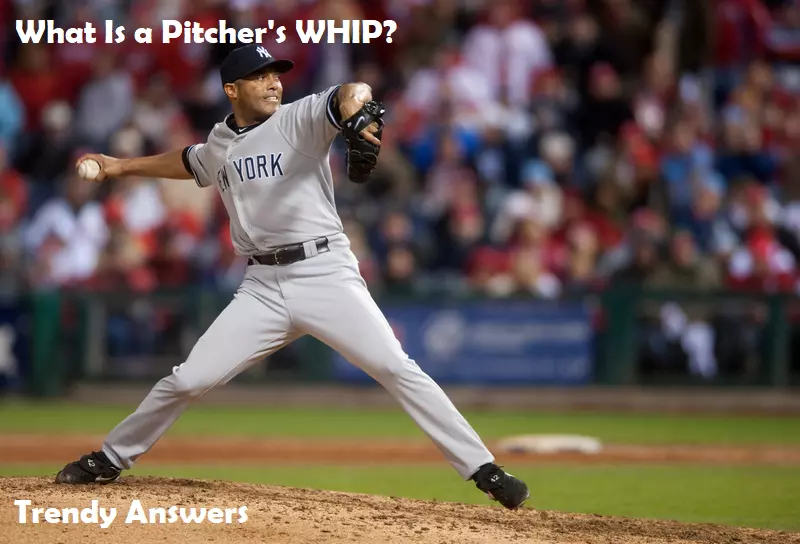What is WHIP in Baseball? WHIP means “Walks and Hits per Innings Pitched” and is a baseball pitching stat that tells you the average amount of walks and hits per innings that the pitcher can give up.
It’s a basic measure to figure out the number of hits and walks per inning that a pitcher will give up. This can be used to assess the possibility for an individual pitcher to allow runs. Each baserunner can be a potential run. In this article, we will discuss what is WHIP in Baseball?
What is WHIP in Baseball?
The term “WHIP” refers to the walks and hits per innings pitched by an MLB pitcher tracks. The formula determines the number of baserunners a pitcher surrenders per innings.

In the theory of things, the team and fantasy baseball players take the WHIP number as a sign that the pitcher has done their job by keeping base runners off bases. In addition, intentional walks count against WHIP. However, this may alter this stat for an individual pitcher if the decision is made by the manager.
How to Calculate a Pitcher’s WHIP?

WHIP = (Walks + Hits) / Total Innings Pitched
Let’s say that Pitcher A concluded the season with sixty walks and 275 strikes and pitched an average of 210 innings. The pitcher wants to determine their statistics on their pitching throughout the season, and therefore they determine their WHIP.
(60 walks + 277 hits) = 335
335 Walks Plus Hits 220 Total number of innings pitched 1.59 WHIP
Related: How Many Innings in Baseball Game?
What Is a Pitcher’s WHIP?

The main purpose of a pitcher is to prevent the opposing team from scoring any runs. Naturally, to gain runs the opposing team must have batters get to the base, so stopping base runners will usually result in fewer runs being allowed.
A pitcher’s WHIP which is also known as the number of walks and hits per pitch is a ratioed stat (or rate statistic) that determines the number of baserunners that a pitcher can allow per inning, based on two principal ways batters get to the base by hitting and walks.
Since the statistic doesn’t take into account batters who hit via a hit-by-pitch the WHIP is not able to determine precisely the number of baserunners per innings that a pitcher is allowed to allow (assuming that a pitcher hits the ball at least once during a season).
It is also not a factor in mistakes, since they occur by defenders and don’t directly show the ability of a pitcher to pitch.
There’s also a number known as Baserunners Per 9 Innings (MB/9) that takes into account hit-by-pitches as well as hitting and walks. Thus, a pitcher’s MB/9 is very like his WHIP although it may differ in some instances.
The problem is that MB/9 does not have any use in the mainstream, and therefore is a relatively obscure and irrelevant statistic, with WHIP at the top of the list.
Read More: How Long is a Baseball Game?
Caveat of WHIP
The limitation is that WHIP does not consider how a batter completes bases. For instance, it doesn’t consider instances of hit-by-pitches which are known as hit batsmen. Therefore, even if the pitcher hits at most one batter per season, WHIP isn’t an accurate measurement. Errors and those who score on the fielder’s selection will not be considered. It is however likely that this will be a better representation of the performance of any pitcher.
Associates of WHIP
The WHIP value is usually compared with another statistic: ERA–earned run average. In many instances, it is evident that pitchers who have a high WHIP also have a great ERA value. Similar to WHIP, the lower ERA that a pitcher is the better. Top-ranked pitchers usually perform well in both the WHIP and ERA ratings.
Purpose of WHIP
A large number of baseball people pay attention to WHIP for good reasons. Based on an analysis conducted by Lahman Baseball Database, strong WHIPs are associated with winning. Simply said, a team with higher WHIPs tends to be also the one that is winning. It’s considered to be an effective rate indicator to determine the number of runs permitted.
Also Read: How Many Baseball Games are in a Season?
What is the difference between WHIP and ERA?
The WHIP stat is different from ERA because they both measure two distinct aspects of pitching. An ERA is the number of earned runs pitched to the batter in total innings pitched. Earned run can range from a single that leads the home run.
Whatever the case of the situation, an ERA typically reflects the pitcher who allows the baserunner to make it to home plate. Unearned runs aren’t counted against the ERA however, having more runners on the bases is the place where WHIP is in play.
The WHIP stat is an effective way of assessing the performance of a pitcher before when the team scores. If a pitcher pitches into the same inning and gives pitches and walks can eventually lead to runs. Sometimes, a pitcher might succeed in getting out of a messy spot by executing a double play.
However, having baserunners in every inning can increase the likelihood of allowing runs to run that is why WHIP is a great reference point to think about when deciding whether to take the time to select a pitcher for your team.
Related: What Is a Balk in Baseball? – 8 Examples
How to Use WHIP Appropriately?
The WHIP is an extremely useful stat that a bet can use in evaluating games. The WHIP can tell you what you can be expecting from your pitcher, on an inning-by-inning basis and when combined with the ERA can be a reliable indicator of whether a pitcher can get out of difficult situations.
However, just like all statistics and patterns, everything could occur when you are in the game. Bettors must keep an eye on recent trends before placing bets. If a pitcher has had three straight good starts, with an incredibly low WHIP and ERA perhaps it’s because he’s discovered something that is working for him.
If a pitcher with good WHIP/ERA has had trouble and experienced a rise in those numbers throughout three games, there’s something wrong and I wouldn’t put my money that he’s shown that he’s able to correct the issue and get back to his best.
Additionally, baseball is a matchup-centric game, so make sure you be sure to do your homework when choosing the best spots to place bets.
What is WHIP in Baseball? Conclusion:
With that, you’ve concluded this article about what is WHIP in baseball. We hope that you gained many valuable points. To summarize, WHIP is just one of numerous baseball statistics. It’s a measure of the number of walks and hits per inning pitched. It is among the few indicators that can be used to evaluate the pitcher’s performance. If you are comparing the two, a lower WHIP will be better than one with a high.
Related: What is RBI in Baseball?
FAQ – What is WHIP in Baseball?
Why was WHIP created?
The WHIP was developed to measure the effectiveness of rotisserie baseball. It’s now being used alongside ERA to assess the effectiveness of a pitcher. The WHIP is a part of the sabermetric umbrella. Sabermetrics is an objective method to analyze baseball statistics. Statistics like WHIP enable you to concentrate on numbers, not the names of popular players.
What is the difference between WHIP and ERA?
The major distinction between the WHIP and ERA is that WHIP measures the number of base runners your pitcher can allow (via hits and walks) and hit) while ERA is the number of runs allowed by your pitcher. Both stats will show how efficient an individual pitcher is. The fact that your pitcher has put runners on the base doesn’t mean that the runners will score. Combining these two numbers will provide you with a greater understanding.
What is the average WHIP in MLB?
As per Baseball Reference, the WHIP average over the past few years has been about 1.3. The average WHIP in the year 2021 stood at 1.297. The WHIP average for 2020 was 1.327. In 2019 the WHIP average stood at 1.327.
The player with the lowest WHIP in MLB History?
The WHIP that has lowest WHIP recorded for a season in MLB time for one single season has been recorded by Pedro Martinez. In 2000, Pedro Martinez posted a 0.7373 WHIP for the Boston Red Sox. Addie Joss is the record holder for career WHIP at 0.9876. 0.9876.
